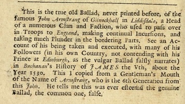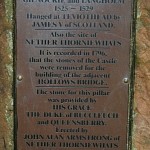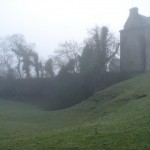Overview
Overview
“Johnie Armstrang” was included in the Minstrelsy from the 1st edition in 1802, and appears in all the subsequent editions covered by this project. It is the 3rd ballad in the 1802 edition.
 “Johnie Armstrang” the first of the reiver ballads which appear in the Minstrelsy. Scott used the version of the ballad printed in the second volume of Allan Ramsay’s publication The Ever Green, which was originally published in 1724. Scott made some editorial changes, but the version of the ballad in the Minstrelsy of the Scottish Border is more or less the same as the one printed in The Ever Green. Scott included Allan Ramsay’s account of collecting the ballad, in his prefatory notes to “Johnie Armstrang.”
“Johnie Armstrang” the first of the reiver ballads which appear in the Minstrelsy. Scott used the version of the ballad printed in the second volume of Allan Ramsay’s publication The Ever Green, which was originally published in 1724. Scott made some editorial changes, but the version of the ballad in the Minstrelsy of the Scottish Border is more or less the same as the one printed in The Ever Green. Scott included Allan Ramsay’s account of collecting the ballad, in his prefatory notes to “Johnie Armstrang.”
History and Background

Plaque by Bridge © Copyright Anne Burgess and licensed for reuse under this Creative Commons Licence
The historic precedent for this ballad is the execution of John Armstrong, brother to Thomas Armstrong of Mangerton, one of the dominant factions of the Armstrong family in the Scottish Border area. The execution followed an expedition into the Borders by King James V and his men, which was one of several intended to disrupt, if not destroy, the power and influence of the major reivers and their families. From existing accounts and documents, we know the progress of the king through the Border country, and that he was at Carlenrig on the 5th of July 1530. Johnie Armstrong was certainly dead by the 8th of July 1530, as there is a document bestowing land and property to Lord Maxwell.
The Armstrongs were one of the most notorious Border clans, and appear repeatedly in reports from the 1500s. Their strongholds were in Liddesdale, and the dominant factions included the Mangerton and Whithaugh families, and they were one of the perpetual thorns in the sides of the March wardens of both sides of the Borders. However, the Armstrongs did not have a defined overall leader, and, as such, are often referred to as a “broken” clan or family. Armstrong factions often adhered to the Maxwells and also the Scotts of Buccleuch. They often married members of the Graham family, which was equally if not more notorious. John’s son and grandchildren were also noted reivers.
The ballad presents the character of Johnie Armstrong as an honourable, powerful hero, protecting the Scottish Border land from the English. In contrast, the King is portrayed as being envious and duplicitous. Johnie is portrayed as living in Gilnockie. There is some debate over the location of this tower.
It stood near the town of Canonbie, now in Dumfries and Galloway, and while many believe it to have been destroyed, the current Gilnockie Tower, also known as Hollows Tower, is a good example of the type of fortified dwelling the more dominant and successful reivers inhabited.dominant factions included the Mangerton and Whithaugh families, and they were one of the perpetual thorns in the sides of the March wardens of both sides of the Borders. However, the Armstrongs did not have a defined overall leader, and, as such, are often referred to as a “broken” clan or family. Armstrong factions often adhered to the Maxwells and also the Scotts of Buccleuch. They often married members of the Graham family, which was equally if not more notorious. John’s son and grandchildren were also noted reivers.
The King mentioned in the ballad is King James V. More information about King James V
